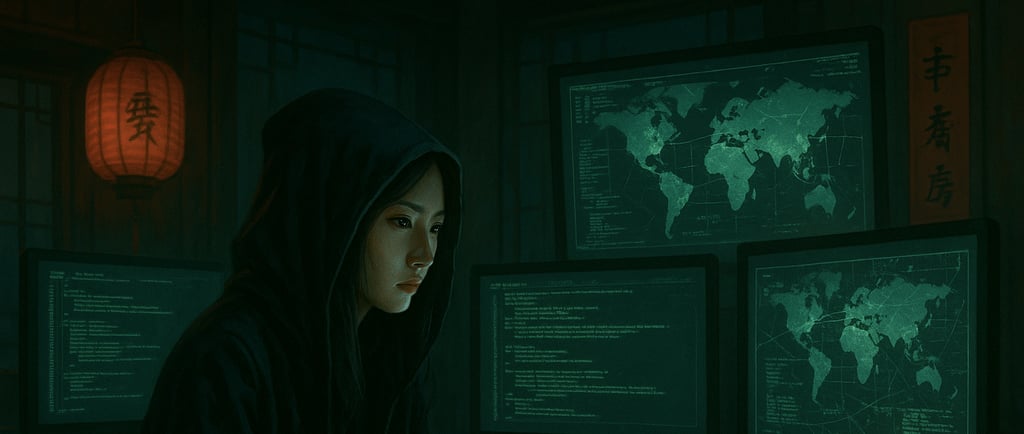
Xiao Tian and the China Girl Security Team: Separating Fact from Fiction
Separating Fact from Fiction
Shane Brown
7/14/20254 min read


Xiao Tian and the China Girl Security Team: Separating Fact from Fiction
In the shadowy world of cybersecurity, few stories capture the imagination quite like that of Xiao Tian and her all-female hacking collective. Yet beneath the compelling narrative of a young woman challenging male-dominated hacking culture lies a web of claims that demand closer scrutiny. This investigation explores what we actually know about one of cybersecurity's most intriguing yet unverified legends.
The Legend Takes Shape
Picture this: A 19-year-old woman from Hunan Province, born on September 6, 1989, decides she's had enough of being marginalized in China's male-dominated hacking community. So she does something unprecedented—she creates her own all-female hacking group. This is the story of Xiao Tian and the China Girl Security Team, a narrative that has captivated cybersecurity enthusiasts for over a decade.
According to the prevailing accounts, Xiao Tian established the China Girl Security Team around 2007-2008, with the group's website officially registered on March 12, 2007. The organization allegedly grew to include over 2,200 female members, emerging from frustration with a hacking culture where women felt excluded and undervalued. It's a powerful origin story that resonates with anyone who's witnessed gender dynamics in tech fields.
But here's where things get complicated: despite the story's widespread circulation, verifying these claims proves surprisingly difficult.
The Claims That Made Headlines
The China Girl Security Team didn't just exist in obscurity—if the stories are true, they made waves. Some sources claim the group was involved in attacks against Google's infrastructure, employing sophisticated techniques like SQL injection attacks. The narrative paints Xiao Tian as a formidable figure who could hold her own against any male hacker while building a sisterhood of cyber warriors.
These aren't small claims. We're talking about allegations of attacks against one of the world's largest tech companies during a period when Chinese cyber activity was increasingly making international headlines. The timeframe aligns perfectly with major incidents like Operation Aurora, which targeted Google and other companies between 2009-2010.
Yet when you start digging deeper, the foundation of these claims begins to feel less solid.
Red Flags in the Digital Evidence
Here's what should concern any cybersecurity professional examining this case: the sources. Most information about Xiao Tian comes from blogs, personal websites, and informal publications rather than established cybersecurity research organizations or law enforcement agencies.
Even more troubling is the circular nature of the reporting. You'll find the same claims repeated across dozens of websites, but trace them back, and they often lead to the same original, unverified sources. It's like a game of telephone played across the internet, where each retelling adds legitimacy simply through repetition.
Consider what's missing from credible cyber threat reporting:
Technical indicators that would prove attacks occurred
Malware analysis showing the group's methods
Law enforcement statements about investigations
Independent verification from multiple authoritative sources
These elements are standard in legitimate cybersecurity incident reporting, yet they're conspicuously absent from the Xiao Tian narrative.
Context Matters: The Real Landscape
This doesn't mean the story is entirely fictional. Female participation in Chinese hacking culture is well-documented, with mentions of earlier groups like the "Six Golden Flowers." The broader context suggests that organized female hacking groups in China could plausibly exist.
The timing also makes sense historically. The period from 2007-2010 saw increased Chinese cyber activity and the emergence of more sophisticated threat groups. Major cyber incidents were making international news, creating an environment where stories about Chinese hackers found eager audiences.
But correlation isn't causation, and plausible context doesn't validate specific claims.
Why This Matters Beyond One Story
The Xiao Tian case represents something larger than one potentially mythical hacker. It demonstrates how cybersecurity narratives can take on lives of their own in our interconnected world. A compelling story, once seeded online, can spread and gain apparent credibility simply through repetition.
For cybersecurity professionals, this case offers crucial lessons:
Source verification is everything. In a field where threat intelligence drives critical security decisions, the standard of evidence must remain high. Sensational stories make for good reading, but they can also distract from real threats or create false attribution.
Gender representation deserves serious study. The fascinating aspects of female participation in hacking culture merit genuine academic research, not sensationalized accounts. Women in cybersecurity face real challenges that deserve documentation based on facts, not folklore.
Critical thinking never goes out of style. Every claim, no matter how widely repeated or intuitively appealing, benefits from rigorous examination.
The Verdict: Legend or Reality?
So what's the truth about Xiao Tian? The honest answer is that we simply don't know. She may represent a real individual who participated in Chinese hacking culture, or she may be a composite character born from internet mythology. The specific claims about her activities and impact remain largely unverified despite their widespread circulation.
What we can say with confidence is that the story has become part of cybersecurity folklore, circulating in discussions and articles without the rigorous verification that serious threat intelligence requires. Until credible sources and evidence emerge, Xiao Tian's story serves better as a reminder about information verification than as documented cyber threat history.
Moving Forward: From Folklore to Facts
The legend of Xiao Tian continues to fascinate, and perhaps that's okay. Stories have power, and this one highlights important themes about gender, technology, and international cyber dynamics. But as cybersecurity professionals and researchers, we must distinguish between compelling narratives and verified intelligence.
The real challenge isn't debunking every unverified story—it's maintaining rigorous standards while remaining open to diverse voices and perspectives in cybersecurity. Women like Xiao Tian, whether legendary or real, remind us that the future of cybersecurity depends on including everyone in the conversation.
In the end, perhaps the most important truth about Xiao Tian isn't whether she existed, but what her story represents: the need for better representation, documentation, and understanding in the evolving landscape of cybersecurity. That's a mission worth pursuing, regardless of any individual legend's veracity.
Innovate
Building websites and securing your digital presence.
Connect
Support
Info@sinistergatedesigns.com
© Sinister Gate Designs, LLC 2025. All rights reserved.
